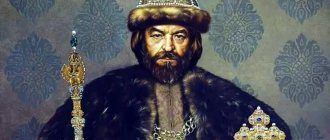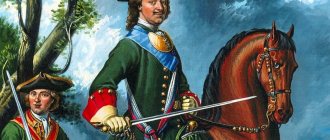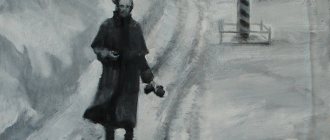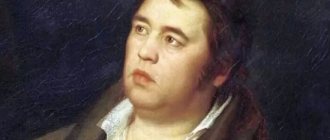Leave your comment
Gift certificates
Responsibility for resolving any controversial issues regarding the materials themselves and their contents is taken by the users who posted the material on the site. However, the site administration is ready to provide all possible support in resolving any issues related to the work and content of the site. If you notice that materials are being used illegally on this site, please notify the site administration using the feedback form.
All materials posted on the site were created by the authors of the site or posted by users of the site and are presented on the site for informational purposes only. Copyrights for materials belong to their legal authors. Partial or complete copying of site materials without written permission from the site administration is prohibited! The opinion of the administration may not coincide with the point of view of the authors.
Source
Plot
In the analysis of the fable “Frogs Asking for the Tsar,” the student needs to tell about the main characters of the work. It tells of frogs who cry out to the heavens asking for a ruler. And the great Zeus listens to their prayers - he gives them a quiet and calm king who does not darken the lives of the inhabitants of the swamp.
But even in this case, the frogs begin to grumble to heaven. After all, this ruler does not demand anything from them. And then the angry ruler of the world sends them another king - one who punished them without trial. Again they turned their prayers to heaven. But this time Zeus did not heed their request. After all, now they have themselves to blame. The stupid frogs didn't appreciate what they had, and now they have to deal with the consequences of their shortsightedness. God answers them that now it is better to remain silent so that something even worse does not happen.
Presentation on literature “Fables by I.A. Krylova" (8th grade)
art therapy specialist
Description of the presentation by individual slides:
Quiz “Fable Experts”
“The red summer sang” “You are to blame for the fact that I want to eat” “He listens and eats” “The breath stole from my goiter with joy” “Why should a godmother work, isn’t it better to turn to yourself, godfather?” What hero of the fable are we talking about? Dragonfly Wolf Monkey Crow Cat Vaska
Foka Pig Pug Cook Crow Lamb Cuckoo Ant Fox Cat Wolf Elephant Rooster Dragonfly Demyan Oak “Get a Pair”
Reflection of historical events of 1812 in the fables of I.A. Krylova
Fable “Frogs Asking for the Tsar” What doubt is expressed in this fable? What traits does Krylov give to the Crane? Why were the frogs punished? What new things have you learned about the fabulist’s views? What are the artistic merits of a fable?
Work in groups Read the fable. Select heroes. Write down their actions and speech characteristics. Find who is “hidden” in the allegories. Give reasons for your answer (prove, explain your choice). Atamanova I.V.
Group 1: fable “Wagon Train” Group 2: fable “Wolf in the Kennel” Historians Group 3: historical commentary on the fables Researchers: Atamanova I.V.
Fable “OBOZ” Good horse – Young horse – Atamanova I.V. Kutuzov Tsar Alexander I and military youth
Moral: Just as many people have the same weakness: Everything in another seems like a mistake to us; If you get down to business yourself, you'll end up doing something twice as bad. Atamanova I.V.
Fable “WOLF AT THE KENNEL” Wolf – Sheepfold – Kennel – Hunter – Atamanova I.V. Napoleon; Russia; Russian army; Kutuzov
Moral: Therefore, my custom is: There is no other way to deal with wolves than by skinning them. Atamanova I.V.
Homework: Learn one of the fables by heart.
A presentation for a literature lesson (according to T. Kurdyumova’s program) on the topic “Historical fables of I. Krylov” contains illustrative material. There is a quiz on knowledge of fables, lexical work on literary theory, and group work.
Material number: 144513
Didn't find what you were looking for?
Essays
Krylov is a fabulist of the spirit of classicism. In his works he uses allegory and very often takes a historical basis for them. For example, as in the fable Frogs asking for the king. The fable takes its history from 1809. It was in that year that Krylov wrote one of his works. The plot is borrowed from La Fontaine, who at one time, referring to the works of Aesop, wrote his creation of the same name. Now we have to explore Krylov’s fable and analyze it.
Analysis of the fable Frogs asking for the king
In Krylov's work Frogs Asking the Tsar, we are talking about frogs. At the very beginning, we see how tired they are of their free life, they don’t like popular rule, so they ask the gods to send a king, thereby depriving themselves of freedom in advance. And the gods heard the frogs, and sent them a calm, silent, sedate ruler, who was like a log of aspen. At first the frogs were afraid of him, but then they realized that they could climb on his head. True, it seemed to them that they could get an even better king, who would bring glory to their swamp.
And now, a new hero appears in the person of the Crane. Now the frogs have a king who, indiscriminately who is right and who is wrong, accuses and immediately puts the guilty in his mouth. Everyone was now afraid of such a king and it was scary to show himself to him, because he could immediately swallow him. They began to ask the gods again for a new ruler, but they had already refused their annoying request. And then we see the moral of the fable. At the request of the frogs, they were given a king, but he turned out to be too quiet. They gave another king to the petitioners, but he was very dashing. And Krylov, as a conclusion, writes that the frogs should live with the second, otherwise the third king may turn out to be even worse than the previous two.
It follows from the fable that we must appreciate what we have, although by nature we always want more and better. Indeed, in reality, as in the fable, the result often turns out to be exactly the opposite of our desires.
When analyzing the fable, you can see ordinary people in the depicted frogs, but Krylov, most likely, did not depict any specific king as the rulers. Perhaps in the first case this refers to Tsar Mikhail, who had to rule the state at a young age without life experience, and in the second version life under Pyotr Alekseevich is depicted. Although, no matter what period you take, there has always been and will be a conflict between the authorities and the people. This is shown to us in Krylov’s fable.
You can listen to the fable of the Frogs Asking the Tsar on our website. Read by Pavel Besedin.
Presentation on literature for a lesson on the fable by I.A. Krylov "Oboz"
art therapy specialist
Description of the presentation by individual slides:
K. Bryullov Volkov R.M.
Ivan Eggink I. A. Krylov at the Monument “1000th Anniversary of Russia” in Veliky Novgorod
Group 1 Comment on the words and expressions: on the sacrum; sculpts like a cancer; strain; you'll do a mischief. Select outdated word forms and expressions from the text of the fable. Select correspondences from modern language for them by filling out the table: Necessary Leaving That's a wonder Look at us Don't be afraid of mischief
Group 2 Answer to question 1 from the section “reflecting on what we read.” What allegorical meaning do the images of a horse, a young horse, a steep mountain, a wagon train have in the fable? Read the young horse’s “monologue” expressively. What role do numerous exclamation structures play in it? In what ways is the dynamics of the pictures conveyed at the end of the fable (the last 6 lines before the moral)? Comment on the moral of the fable.
Moral of the fable: Ridicule of vices: arrogance, irresponsibility, arrogance
Group 3 Read the textbook article about the fable “Oboz”. Comment on historical and cultural realities and characterize historical figures: The Patriotic War of 1812, Alexander 1, the surrender of Moscow to Napoleon, the Prince of Württemberg, the Battle of Austerlitz. Answer to question 2 from the textbook section “Reflecting on what we read.”
Historical basis of the fable “Oboz” Criticism of the intervention of Emperor Alexander I in the strategy and tactics of Kutuzov in the Patriotic War of 1812
Group 4 Look at the illustration by the artist A. Laptev for the fable “Wagon Train”. What are the similarities and differences between the illustrations? What words from the fable could become captions for these illustrations? Answer to a question from the section “Literature and other arts.”
Practical work Points of the plan Quotation plan Forms of expressing the author's position 1. 2. 3. 4.
Practical work Points of the plan Quotation plan Forms of expressing the author’s position 1. Descent of the first cart from the mountain 2. Accusatory “monologue” of a young horse 3. Descent of a young horse with a cart 4. Moral
Practical work Points of the plan Quotation plan Forms of expressing the author's position 1. Descent of the first cart from the mountain “The owner began to lightly bring the first cart” 2. Accusatory “monologue” of the young horse “And the horse on top, young, / scolds the poor horse for every step” 3. Descent with a cart of a young horse “The horse set off on all four legs / To the glory / Over the stones, ruts” 4. Moral “If you get down to business yourself, you will commit a mischief twice as bad”
Practical work Points of the plan Quotation plan Forms of expressing the author’s position 1. Descent of the first cart from the mountain “The owner began to lightly carry the first cart” Epithet: good horse 2. Accusatory “monologue” of the young horse “And the horse above, young, / scolds the poor horse for every step" The author's irony in relation to the young horse, expressive exclamatory intonations 3. The descent of the young horse with the cart "The horse set off on all four legs / To the glory / Over the stones, ruts" Inappropriate speech, rhetorical exclamations, ironic appeals 4. Moral "And you will take it get down to business yourself, so you’ll punish twice as bad.” Identification of images of animals and human vices, disclosure of the allegory by the author
Literary terms Personification Reification Personification
Homework Expressive reading of a fable by heart. Answer the question in writing: “How are the historical events of the War of 1812 reflected in the fable “Oboz”?”
Materials from N.V.’s manual were used. Belyaeva “Literature lessons in 8th grade”
Material number: DB-335904
Didn't find what you were looking for?
You might be interested in these courses:
Plot
In the analysis of the fable “Frogs Asking for the Tsar,” the student needs to tell about the main characters of the work. It tells of frogs who cry out to the heavens asking for a ruler. And the great Zeus listens to their prayers - he gives them a quiet and calm king who does not darken the lives of the inhabitants of the swamp.
But even in this case, the frogs begin to grumble to heaven. After all, this ruler does not demand anything from them. And then the angry ruler of the world sends them another king - one who punished them without trial. Again they turned their prayers to heaven. But this time Zeus did not heed their request. After all, now they have themselves to blame. The stupid frogs didn't appreciate what they had, and now they have to deal with the consequences of their shortsightedness. God answers them that now it is better to remain silent so that something even worse does not happen.
Leave your comment
Gift certificates
Responsibility for resolving any controversial issues regarding the materials themselves and their contents is taken by the users who posted the material on the site. However, the site administration is ready to provide all possible support in resolving any issues related to the work and content of the site. If you notice that materials are being used illegally on this site, please notify the site administration using the feedback form.
All materials posted on the site were created by the authors of the site or posted by users of the site and are presented on the site for informational purposes only. Copyrights for materials belong to their legal authors. Partial or complete copying of site materials without written permission from the site administration is prohibited! The opinion of the administration may not coincide with the point of view of the authors.
Source
Morality
An analysis of the fable “Frogs Asking for the Tsar” will be incomplete without highlighting the moral aspect. Its reader can find in the words of the god Jupiter, who is sincerely perplexed why the frogs could not live happily when they had all the conditions for this. These words are quite applicable in situations where people had opportunities to improve their situation. However, they did not take advantage of these chances. And after that they complain to others about their misfortunes.
The fabulist writes in an allegorical form about those people who are ready to transfer self-determination into the wrong hands. They don't want to organize their lives. Like stupid frogs, such people want to follow a routine established from the outside. However, such ordinary people are never happy with the current situation. The reason for this may be either a real danger looming over them, or their stupidity and inability to appreciate the good that is available. After all, someone who does not want to take responsibility for their life has the most primitive interests, one of which is the senseless manifestation of arrogance and criticism.
Krylov's views and their expression in fables
In any case, the phrase spoken by Zeus at the very end of the work makes an indelible impression. It sounds like this: “Live with him so that it doesn’t get worse for you!” Thus, an analysis of the fable “Frogs Asking for the Tsar” allows us to say that this is a very sharp and acute topic in which the author tried to maximally express his negative attitude towards the ruling imperial elite. The fabulist believed that there are no good kings and each subsequent ruler will only get worse. During his creative life, the demon Ivan Andreevich Krylov wrote a lot: “The Frog Asking for the Tsar”, “Wagon Train” and others, in which he, without fear of punishment, boldly shows his attitude towards the Russian tsars.
Thus, the moral of the fable can still be applied today. No matter how good a leader or ruler is, a person always expresses his dissatisfaction with his work and wants something new. And he may turn out to be a fake log or a crane.
In the fable “Frogs Asking for a Tsar,” funny and sad things happen at the same time. The frogs were unable to live under “people's rule,” that is, without supreme power. They began to ask the gods for a king.
Twice the gods sent them a ruler, both times it had dire consequences. In the first case, “this king was a log of aspen,” and in the second, “the Crane.”




